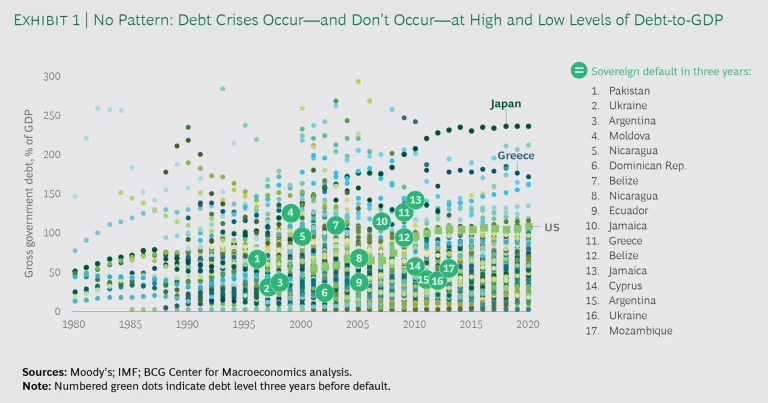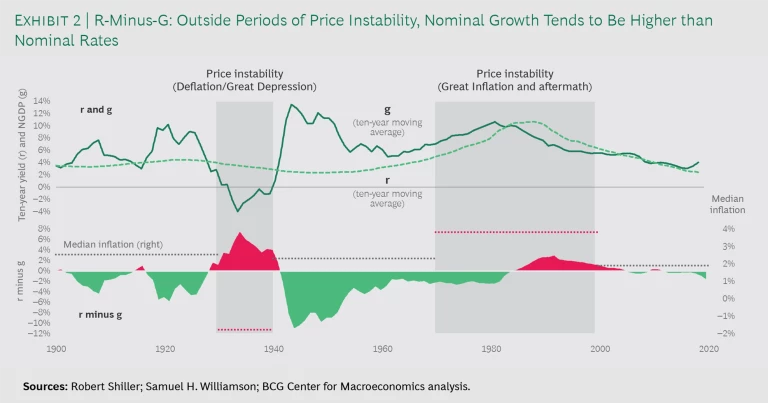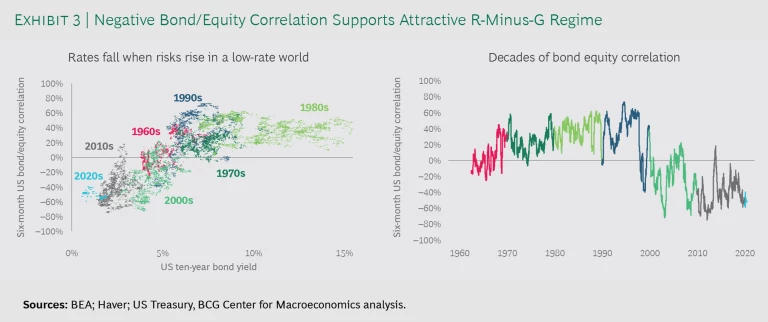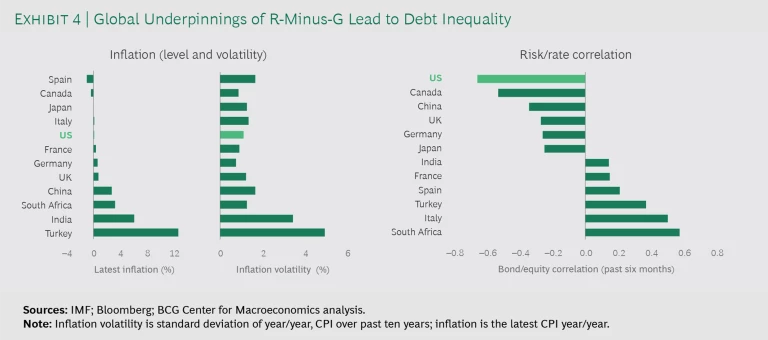In normal times, the public debt does not feature much in conversations with investors and business leaders, who tend to view it as a detail of the macroeconomic context. But COVID-19 has made the macro context critical to companies’ outlook, and public debt—which has jumped to near record levels in many economies, including the US—attracts much concern. This is understandable because sovereign debt problems could create a more toxic business environment than even a deep recession. Has debt risen too far too fast, and should we worry about it?
While public debt is discussed widely in the current context, it is also widely misunderstood. It’s tempting to think that more debt is worse, that higher levels go with greater risks, that a recession certainly makes debt less sustainable, and that there must be a critical level of debt that marks a breaking point. In reality, public debt is far more complex, and debt levels are a poor indicator of economic risk.
We caution against a focus on debt levels and stress instead the interplay of nominal interest rates and growth rates (the “r-minus-g” framework), the influences on the relationship of these two variables, particularly during and after moments of crisis, and what the balance of risk will likely be between too little and too much debt. Strongly anchored inflation, negative risk/rate correlation, and global currency demand will likely see the debt capacity of some economies strengthen, not weaken. But not all countries benefit from these dynamics; the shock will likely produce greater debt inequality globally.
In the near term, the main risk is not too much debt, but too little, as fiscal efforts will remain critical to support fragile and uneven recoveries. A misguided focus on debt levels could spawn an ill-timed (that is, procyclical) emphasis on fiscal rectitude in politics that would threaten the nascent and fragile recovery.
Why Debt Levels Are a Red Herring
Although habitual use of public debt to generate artificially higher growth is ultimately problematic, it’s worth remembering that more debt is better than less debt in times of crisis, such as now. When the real economy is in freefall, rising debt levels can contain the collapse of company and household balance sheets and foster recovery. In fact, a failure to use fiscal policy helped push the US economy into depression in the 1930s, and swift and strong policy responses by central banks and governments have so far prevented even worse (systemic) meltdowns in the current crisis.
Yet, despite such necessary spikes, debt levels (the debt-to-GDP ratio, total public debt divided by total national income) are now watched carefully and widely warned against. There is often talk of “thresholds”—the levels that will trigger debt crises or a slump in growth. But while the desire for a simple metric is understandable, public debt does not work as mechanically as this.
Consider the public debt levels for 190 countries over 40 years, along with recorded sovereign defaults (see Exhibit 1). There is no correlation between debt levels and defaults. Instead, the data tell us, quite clearly, that sovereign debt crises occur—or do not occur—at high levels and at low levels of debt.
Focus Instead on R-Minus-G
The difference between an economy’s nominal interest rate and its nominal growth rate offers a much stronger framing of risk.
As long as nominal interest rates are below nominal growth (that is, r – g < 0) there is no additional burden in keeping debt-to-GDP levels stable. Put simply, all interest can be paid by issuing new debt and the debt ratio would still fall. Alternatively, the debt ratio can be kept stable even while adding new debt unrelated to interest (to the tune of the difference between r and g times the debt ratio). And if the debt ratio can be held stable with little effort, there are fewer reasons to worry about sustainability and crisis.
Is r-minus-g < 0 a normal or an exceptional state of affairs? The US economy over the past 120 years tells us that nominal growth exceeding nominal rates is the norm. In fact, r > g is the anomaly, which has occurred only around periods of price instability (specifically, amid deflation in the 1930s and in the aftermath of too-high inflation in the 1980s and 1990s). In fact, this favorable backdrop (r < g) is common in many parts of the world. (See Exhibit 2.)
It’s worth noting that r-minus-g can be favorable (that is, the spread is negative) for different reasons: either because growth is very strong or because rates are very low. While it is intuitively preferable to have a negative r-minus-g spread because of very strong growth, a spread resulting from very low rates has the same mechanical impact on debt dynamics.
Look at the Drivers
To assess how COVID-19 impacts a country’s sovereign debt capacity and risks, we must take two analytical steps: first, understand the drivers of r-minus-g, and second, determine if COVID-19 can impact those drivers and thus an economy’s r-minus-g dynamics. A handful of drivers shape r-minus-g:
- Inflation regime. Low inflation and inflation expectations deliver low nominal interest rates. When they are low and stable, inflation risk premiums (as opposed to just inflation compensation) will be low on public debt, helping rates stay low relative to growth (favorable r-minus-g spread). Thus, the inflation regime is crucial to delivering a favorable r-minus-g regime.
- The correlation of risk and interest rates (bond/equity correlation). Negative risk/rate correlation describes economies where interest rates fall (bond prices rise) during periods of crisis, such as the current one. In other words, because the public debt of some economies provides valuable insurance against falling risk assets (such as equities), demand for such debt is higher. The price for this insurance comes in the form of lower rates received by investors on that public debt, helping drive a favorable r-minus-g spread.
- Global demand for currency. Rates can also be pushed down by demand that is driven by reasons other than return. Reserve holders—that is, countries holding a specific currency, such as the US dollar, to provide themselves with a backstop in a crisis—are a key example. The more debt (currency) that is held by reserve holders, the lower the rate is likely to be and thus the more favorable the r-minus-g spread. So, the question is whether there is reserve currency status, how strong it is, and whether a crisis can change it.
- Supply-side drivers (trend growth). We must not forget the g in r-minus-g. If growth falls below rates, as it surely does in times of contraction like the current recession, that seems like a problem. However, what matters is not the short run but the longer term—whether rates will fall further and longer than growth. But changing long-run growth is hard. Nominal growth (g) is the sum of trend growth and realized inflation. And trend growth doesn’t typically change over short periods of time or because of shocks. Rather, it is a function of slowly changing drivers (labor input, capital input, and productivity growth), suggesting that even a severe shock will have a hard time pulling down trend growth.
COVID-19 Strengthens Some Countries’ Debt Capacity
If we consider the drivers above, it becomes apparent that COVID-19 will likely spawn significant inequality in nations’ capacities to sustain debt—even as debt levels are going up everywhere.
Paradoxically, some economies’ debt capacity will likely rise with the pandemic—irrespective of their debt levels—because rates will be suppressed for longer than growth (contributing factors are fears of deflation, higher demand for the insurance provided by negatively correlated assets, increased demand for reserves, and policy rates staying low). For other economies, it will be the opposite; COVID-19 could push them into debt defaults, currency crisis, and inflation. Largely speaking, it’s the wealthiest economies that benefit, underlining the inequality of the crisis.
To illustrate, consider the US case, which describes numerous other economies too. There is much concern about US debt levels (81% of GDP, 108% if we include debt that the government itself holds). While such numbers are high relative to the situation in most of the country’s history, the narrow focus on debt levels is blind to the fact that r-minus-g is quite favorable for the US, and COVID-19 likely makes it even more favorable in the medium term.
If we consider the drivers of r-minus-g outlined above, we can see why:
- In the US, the inflation regime has a strong foundation with deeply anchored expectations. The risk of a structural inflation break is very low. If anything, fears tilt toward deflation, plausibly putting a negative inflation risk premium on interest rates.
- Risk/rate correlation is deeply negative, and indeed the insurance value of public debt (rates) was exhibited in the current crisis when equities crashed and US debt rallied (yields fell from 1.92% at the start of the year to 0.54% in early March). (See Exhibit 3.)
- The value of holding US dollar reserves in the rest of the world was proven again as the crisis pushed the dollar higher, and it’s worth noting that there is no viable competitor for the primary reserve currency.
- Lastly, trend growth (that is, growth outside of cyclical fluctuations) is unlikely to be affected by COVID-19. The crisis will deliver a one-off hit to capital formation as businesses fold, capex falls, and the capital stock grows less. However, permanently changing the supply-side drivers (labor, capital, and productivity) is a high bar, even for a severe crisis.
COVID’s Impact Furthers Debt Inequality Globally
There are nevertheless many weaker economies with unfavorable r-minus-g dynamics or favorable dynamics that could flip to unfavorable (the crisis flipping r to be greater than g). It is important not to equate unfavorable r-minus-g dynamics with “emerging economies.” There are advanced economies with unfavorable r-minus-g (Italy, for example), and there are emerging economies with very favorable r-minus-g (China, for example).
The truly unfavorable and risky situations are in those economies where rates exceed growth by a large margin—South Africa comes to mind. In many such economies, the drivers outlined above work in opposite directions: inflation is unstable, risk-rate correlation is positive, and, contrary to reserve currency status, such countries must build reserves and worry about outflows. Also, while r-minus-g captures debt risks far better than debt-to-GDP levels alone, the framework faces its own limitations because national idiosyncrasies can play a large role. For example, reliance on foreign currency debt, such as Turkey’s, adds dimensions of vulnerability not captured by domestic currency r-minus-g. (See Exhibit 4.)
The Near-Term Risk Is Not “Too Much” but “Too Little”
As economies begin to reopen and the risk of extended first waves, second waves, and new lockdowns persists, debt will continue to play an important role in containing the damage and shaping the recovery. In other words, the balance of risk is in favor of too much debt rather than too little, certainly in those economies whose debt capacity is likely to grow, as argued above. In assessing the role of debt in the months ahead, the key analytical risks are:
- Underestimating the importance of debt growth to recovery and the risk of politicization of stimulus—the bipartisan efforts in March could falter and turn further debt growth (that is, the stimulus) into a political football.
- Mistaking debt-to-GDP level as a measure of debt sustainability, when in fact it is a poor indicator of risk. Assessing nominal interest rates and growth rates and the forces influencing their spread is a stronger lens on debt risk.
- Inferring country risk from economic development levels. There are advanced economies with weak debt capacity and emerging economies with strong debt capacity.
We continue to believe that the COVID-19 crisis will not translate into a regime break. Policy makers and politicians ultimately have strong incentives to avoid that devastating outcome. But as the crisis passes and the need for stimulus lessens, the balance of risks will shift away from “too little” toward “too much.”
At first this shift in balance of risks will come from the falling benefits of stimulus. But when the economy regains a strong footing, new risks may emerge. This will be particularly true if aggressive stimulus remains in place and pushes on the inflation regime of low, stable, and well-anchored inflation expectations. Although cracking the healthy inflation regime would take time (years) and is a high bar (repeated policy errors), it is not implausible in an age of “compulsive stimulus,” and any crack in price stability would severely undermine debt capacity. At that point the balance of risks would be the opposite of what it is today and the economic consequences would be severe. Today it remains clear that more debt (stimulus) is safer than less, but that does not mean debt growth can continue into perpetuity.










